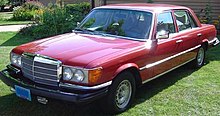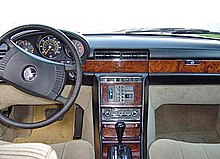
The Mercedes-Benz S-Class, formerly known as Sonderklasse, is a series of full-sized luxury sedans, limousines and armored sedans produced by the German automaker Mercedes-Benz. The S-Class is the designation for top-of-the-line Mercedes-Benz models and was officially introduced in 1972 with the W116, and has remained in use ever since. The S-Class is the flagship vehicle for Mercedes-Benz and is positioned above the other models.

The Mercedes-Benz 300 SEL 6.3 is a full-sized luxury performance car built by Mercedes-Benz from 1968 to 1972. It featured the company's powerful 6.3-litre M100 V8 from the flagship 600 (W100) limousine installed in the normally six-cylinder powered Mercedes-Benz 300 SEL (W109). The result was a nearly 2-ton sports sedan with muscle car performance. At the time of its release it was one of the world's fastest four-door cars.

Hydropneumatic suspension is a type of motor vehicle suspension system, designed by Paul Magès, invented by Citroën, and fitted to Citroën cars, as well as being used under licence by other car manufacturers. Similar systems are also widely used on modern tanks and other large military vehicles. The suspension was referred to as Suspension oléopneumatique in early literature, pointing to oil and air as its main components.
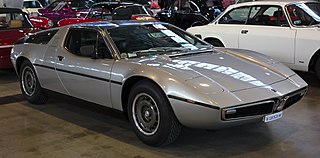
The Maserati Bora is a two-seat, rear mid-engine, rear-wheel drive sports car and grand tourer, manufactured by Maserati from 1971 to 1978. In common with other Maserati cars of the era, it is named after a wind, Bora being the wind of Trieste. The Bora was the company's first mid-engined street car and ended Maserati's reputation for producing fast but technologically out of date cars, also being the first Maserati with four wheel independent suspension. In contrast, competitor Lamborghini had first used full independent suspension in 1964. The Bora was the second-most expensive car of the 1970s following Lamborghini Countach.

The Mercedes-Benz W201 is the internal designation for the Mercedes 190 series sedans, a range of front-engine, rear drive, five passenger, four-door sedans manufactured over a single generation, from 1982 to 1993 as the company's first compact class automobile.
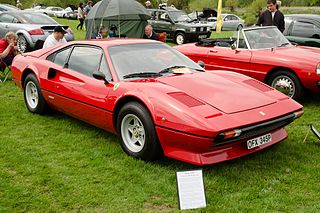
The Ferrari 308 GTB berlinetta and targa topped 308 GTS are V8 mid-engined, two-seater sports cars manufactured by the Italian company Ferrari from 1975 until 1985. The 308 replaced the Dino 246 GT and GTS in 1975 and was updated as the 328 GTB/GTS in 1985. The similar 208 GTB and GTS were equipped with a smaller, initially naturally aspirated and later turbocharged, two-litre engine, and were sold mainly in Italy.
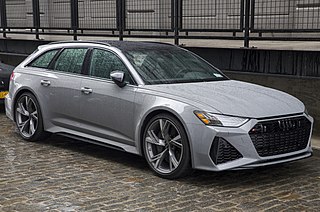
The Audi RS 6 is a high-performance variant of the Audi A6 range, produced by the high-performance subsidiary company Audi Sport GmbH, for its parent company Audi AG, a subsidiary of the Volkswagen Group, from 2002 onwards.
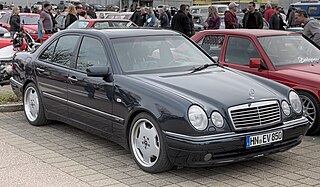
The Mercedes-Benz W210 is the internal designation for a range of executive cars manufactured by Mercedes-Benz and marketed under the E-Class model name in both sedan/saloon (1995–2002) and station wagon/estate (1996–2003) configurations. W210 development started in 1988, three years after the W124's introduction.

The Mercedes-Benz R107 and C107 are sports cars which were produced by Mercedes-Benz from 1971 until 1989, being the second longest single series ever produced by the automaker after the G-Class. They were sold under the SL (R107) and SLC (C107) model names in a variety of names indicating the displacement of the engines.

The Mercedes-Benz R129 SL is a roadster which was produced by Mercedes-Benz from 1988 until 2001. The R129 replaced the R107 in 1989 and was in its turn replaced by the R230 SL-Class in 2002 for the 2003 model year.

The Mercedes-Benz W126 is a series of passenger cars made by Daimler-Benz AG. It was marketed as the second generation of the Mercedes-Benz S-Class, and manufactured in sedan/saloon (1979–1991) as well as coupé (1981–1990) models, succeeding the company's W116 range. Mercedes-Benz introduced the 2-door C126 coupé model, marketed as the SEC, in September 1981. This generation was the first S-Class to have separate chassis codes for standard and long wheelbases and for coupé (C126).
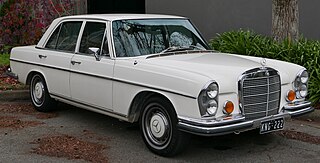
The Mercedes-Benz W108 and W109 are luxury cars produced by Mercedes-Benz from 1965 through to 1972. The line was an upgrade of the Mercedes-Benz W114/W115, to succeed the W111 and W112 fintail sedans. The cars were successful in West Germany and in export markets including North America and Southeast Asia. During the seven-year run, a total of 383,361 units were manufactured.

Active Body Control, or ABC, is the Mercedes-Benz brand name used to describe electronically controlled hydropneumatic suspension.

The Mercedes-Benz W116 is a series of flagship luxury sedans produced from September 1972 until 1980. The W116 automobiles were the first Mercedes-Benz models to be officially called S-Class, although some earlier sedan models had already been designated unofficially with the letter 'S' for Sonderklasse. The W116 was selected as European Car of the Year in 1974.

The Mercedes-Benz W140 is a series of flagship vehicles manufactured by Mercedes-Benz from 1991 to 1998 in sedan/saloon and coupe body styles and two wheelbase lengths. Mercedes-Benz unveiled the W140 S-Class at Geneva International Motor Show in March 1991, with the sales starting in April 1991 and North American launch was on 6 August 1991.

The Audi RS 4 is the high-performance variant of the Audi A4 range produced by Audi Sport GmbH for AUDI AG, a division of the Volkswagen Group. It sits above the Audi S4 as the fastest, most sports-focused car based on the A4's "B" automobile platform. The RS 4 was reintroduced in 2012, based on the A4 Avant instead of the sedan as did the original model.
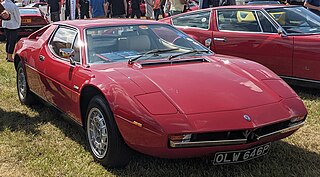
The Maserati Merak is a mid-engined 2+2 sports car produced by Maserati between 1972 and 1983. The Merak was closely related to the Maserati Bora, sharing part of its structure and body panels, but was powered by a 3.0 L V6 in place of the latter's 4.7 L V8. The extra cabin space gained by fitting a smaller and more compact powertrain was used to carve out a second row of seats—suitable for children or very small adults—making the Merak not just a less expensive alternative to the Bora but also a 2+2.
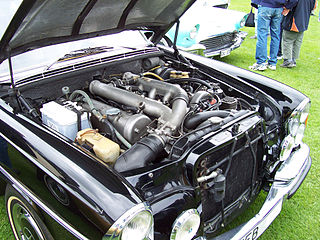
The Mercedes-Benz M100 engine was a 6.3 L (386.4 cu in) single overhead cam V8 produced by Mercedes-Benz between 1963 and 1981. The successor to the M189 version of the company's venerated 3.0 L (183.1 cu in) straight-6 M186, it was introduced in the flagship Mercedes-Benz 600. In 1968, it was fitted to the high-performance Mercedes-Benz 300SEL 6.3 sports sedan. The engine was enlarged to 6.8 L in 1975 for the Mercedes-Benz 450SEL 6.9 (1975-1981). Mercedes-Benz refers to it as a "6.9", despite its actual displacement.
An active suspension is a type of automotive suspension that uses an onboard control system to control the vertical movement of the vehicle's wheels and axles relative to the chassis or vehicle frame, rather than the conventional passive suspension that relies solely on large springs to maintain static support and dampen the vertical wheel movements caused by the road surface. Active suspensions are divided into two classes: true active suspensions, and adaptive or semi-active suspensions. While semi-adaptive suspensions only vary shock absorber firmness to match changing road or dynamic conditions, active suspensions use some type of actuator to raise and lower the chassis independently at each wheel.

The Mercedes-Benz W222 is the sixth generation of S-Class produced from 2013 to 2020, successor of the W221 S-Class and predecessor to the W223 S-Class. The W222 was designed in 2009 by Korean designer Il-hun Yoon, who was inspired by the Mercedes-Benz F700 concept car. The exterior design was developed by a team of designers under the direction of Robert Lešnik. The W222 has a similar design theme to the C-Class (W205) and E-Class (W213).

